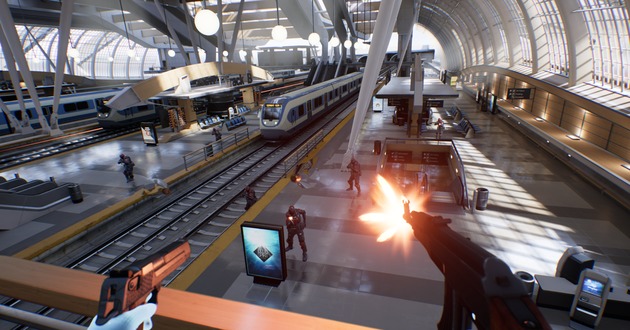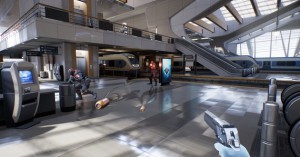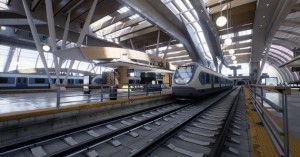Epic Games’ studio in Cary, North Carolina, is unlike anything you’ve seen before. Corridors filled with awards and celebrations of the studio’s history litter the walls as you are lead to huge expanses dedicated to large rooms filled with developers working on various titles for various formats, engine developers and QA testers. But tucked away on an upper level in a small, dark room is the virtual reality (VR) team. A small group of enthusiastic tinkerers that have managed to come up with some of the most exciting works that VR has yet seen, with minimal budget and tight timeframes.
The team’s most recent technical demonstration, Bullet Train, was revealed at Oculus Connect 2, Hollywood, back in September. The experience made quite a splash at the event, showcasing the capabilities of Oculus VR’s motion controllers with the familiarity of a first-person shooter (FPS) videogame; a genre in which Epic Games are nothing less than influential.
Nick Donaldson, Environment Artist & Level Designer, is candid about the ambitions the team had for Bullet Train: “It’s an action game,” he states plainly.
VR is regularly associated with a groundbreaking opportunity to reform society. The potential impact of the technology is unquestionable, yet at the same time it will be entertainment that drives mass adoption. Donaldson identifies that Bullet Train is not a serious exposition of any political or social agenda. It’s a videogame, and it’s meant to be fun. Nothing more, nothing less.
“It makes you a badass, right? In the context of what we were doing, we were still in it to make a demo. It wasn’t to make a game where someone could fail, so it was like ‘you are Neo from The Matrix‘. You are this ultimate badass, and basically you’re fucking shit up.”
Bullet Train casts the player as an unnamed protagonist fighting against literally hundreds of faceless foes, each one dumber than the last. There is no point at which you feel they could take you out, no matter how many bodies are lining up in front of you. They simply can’t match your ability, and this is exactly what Bullet Train was intended to be.
“We basically wanted to take the general themes of Showdown, which are soldiers and slowdown and bullets and explosions, and turn that into a game. We started about 10 weeks ago, just fooling around with a prototype, and it took me about a week and I had guns working,” states Donaldson. “They were just boxes and they looked terrible, but they felt really good to fire. Everyone we showed it to was like, ‘this is really cool’. They had this big grin when people would pick up 2 AK-47s.
“There are so many combinations of things you can do; throw a grenade up into the air and shoot it out of the air or teleport to a guy drop a grenade and teleport back.”
10 weeks is not a very big window for the development of a VR prototype, especially considering the need to incorporate brand new technology and the size of the team working on the project. Donaldson was aware of the limitations from the start, cautious to reign in his ideas with self-imposed limits to those which would make the core experience playable on a basic level yet still be fun.
“There’s definitely a lot of room for massaging and improvement. We only had that 10 weeks from start-to-finish, and it was really only about 5 weeks once we had all of the things polished. We were still fixing bugs up until a few days ago. It didn’t have the same amount of love that we’d normally put into a full product.”
Despite the limitation placed on Bullet Train‘s development, Donaldson is hopeful that the next time Epic Games settles on creating something in VR more resources will be available to the team.
“Showdown was a very highly scripted sequence. There was a fair amount of work that went into making sure that everywhere you look something was happening, but when you actually have input, controls, and you actually have enemies running around you, shooting at you, the amount of work exponentially skyrockets. We found that out as quite a rude awakening!” States Donaldson. “Kim Libreri is our CTO and he’s joined the bandwagon of ‘hey, let’s brew on something a little longer’ now. These things tend to come together pretty quickly; someone has an idea and then we have a deadline, so we do what we do and we do it well.”
One aspect of Bullet Train that has benefited from a great deal of discussion in the VR enthusiast community is movement. The player doesn’t actually walk at all during Bullet Train, regardless of any movement they may make in the real world. Instead, a teleport mechanic is employed: looking at a distant ball of light, the player can attach to it and immediately be teleported to this new location.
“We created the teleportation because if you walk you get motion sickness,” states Jerome Platteaux, Lead Lighting Tech Director. “Teleportation was actually the… everybody who tried it, nobody was getting sick. So we decided this was the way to move around the environment. One thing we tried [was an] elevator or an escalator, and every time somebody said it was not so good. But as soon as you do cuts, it’s kind of easy.”
“We had a day where we tried elevators and escalators both, but they didn’t turn out so well,” adds Donaldson. “We were particularly surprised by the elevator; as we were coming in we were like ‘oh man that floor is rushing up!’.”
All of the mechanics for transporting the player – and the name of the technical demonstration itself – were designed around the location in which Bullet Train would take place. Many venues were discussed, but the team were insistent that they wanted a venue which had more to it than just being a playground for Bullet Train‘s ample destruction.
“One thing we talked about was ‘where can we do something cool to shoot at people?’,” offers Platteaux. “We’d done a street in New York so we thought either airport or train station, and the train station is good because you have trains passing by, so you can use that for storylines, dynamic elements. We wanted to use as much as we can from the engine.”
The train station in which Bullet Train takes place does of course provide ample room for Unreal Engine 4 to stretch its legs. Reflective surfaces, wide open spaces for numerous enemy models, destructible scenery and more make for an exciting venue, but also caused headaches for Platteaux given the demands of VR: high resolution and maintaining a steady framerate of at least 75 frames-per-second, preferably much higher.
Platteaux’s previous experience saw him working in motion-picture production on titles such as How to Train Your Dragon and Megamind at Dreamworks, as well as Industrial Light & Magic’s contributions to Transformers: Dark Side of the Moon and Star Trek Into Darkness, amongst others. During VRFocus‘ time with Platteaux it was remarked that his previous works had allowed him ample time to render a scene – overnight, in fact – even for a single frame. In VR there are no such luxuries.
“It’s really, really hungry, so we have to be really aggressive when we’re optimising as well,” states Donaldson, commenting on Platteaux’s work in the new medium. Donaldson encountered his own problems, too. Once of the most exciting mechanics in Bullet Train is the ability to pluck bullets from the air and throw them back at your enemies with all the force of a gun being fired.
“I had an idea for the bullets right from the beginning. It was one of the first things that I wanted to do and it was one of those things that kept breaking,” states Donaldson as he recalls one of the most problematic parts of Bullet Train‘s development. “So I’d work on it for a while and then I’d work on something else, then I’d get the bullets slowing down and then a few days later the bullets would stop slowing down and I’d be like, ‘why’d the stop slowing down?!’.”
Of course, the team overcame these problems and delivered an experience that was universally praised. Even before the positive reaction, Donaldson was pleased with what the team had managed to produce in their very limited timeframe: “It basically just turned into a little sandbox where some of the things you can do are crazy… we’re treading the line between what actually works and what makes sense.”
Donaldson, despite taking a senior role on this project, is clear about the fact that he has no influence on whether or not Epic Games decide to invest in VR further. However, he’s certainly keen to be on board should the encouraging response towards Bullet Train both internally and externally of the company lead to more opportunities to work in the medium.
“Hopefully at least we give people a bit of a taste for the fact that there is a lot more there. The projection that this could be a full experience.”
-END-
The post Bullet Train: Changing Track With Virtual Reality appeared first on VRFocus.

















